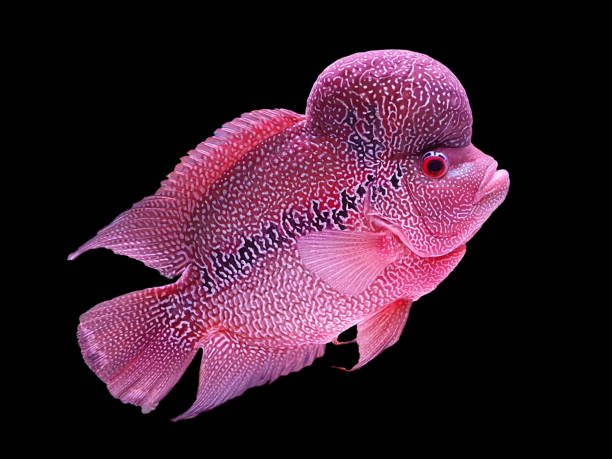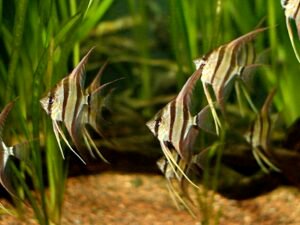Flowerhorn Fish: The Fascinating World of These Unique Hybrid Cichlids
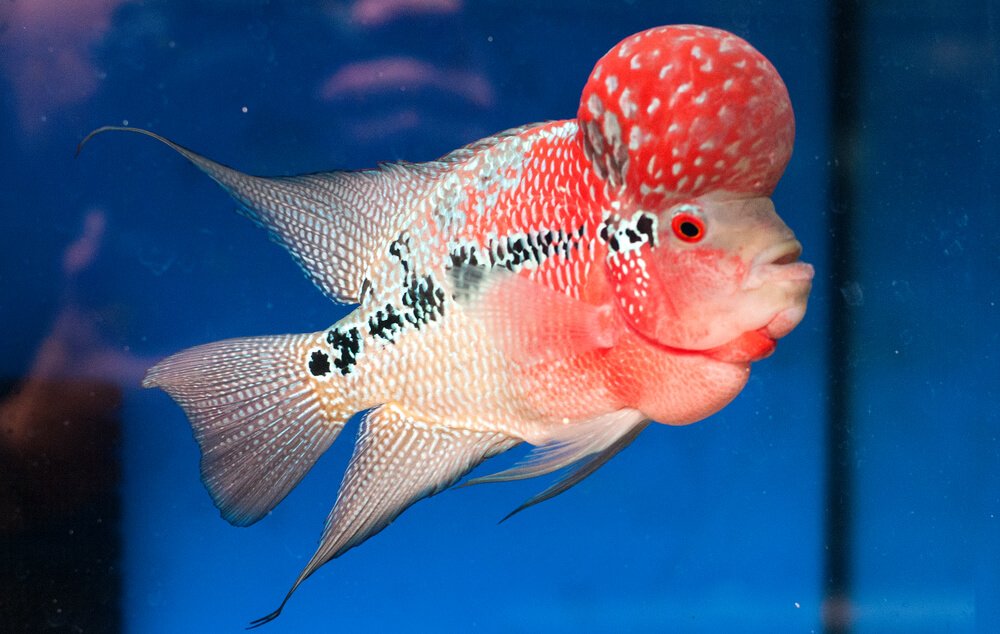
Explore our articles and resources, connect with fellow aquarists in our forums and social media channels, and join us in our mission to create a world where every aquarium is a thriving, beautiful work of art. Together, we can inspire, educate, and empower aquarists everywhere to achieve their dreams and make a difference in the world, one tank at a time.
Flowerhorn
Quick Facts
Scientific Name: Amphilophus labiatus x Amphilophus trimaculatus (hybrid)
Common Names: Flowerhorn cichlid, Luohan, Hua Luo Han
Origin: Artificially developed in Malaysia, Thailand, and Taiwan during the 1990s
Adult Size: Up to 16 inches (40 cm) in length
Lifespan: 10-12 years with proper care
Tank Size: Minimum 75 gallons (284 liters) for a single adult
Diet: Omnivorous, requiring a diverse diet of high-quality pellets, frozen foods, and vegetables
Temperament: Semi-aggressive, best kept individually or with carefully selected tank mates
Difficulty: Intermediate to Advanced
Introduction
Flowerhorn fish have taken the aquarium world by storm since their introduction in the 1990s. These unique and captivating hybrid cichlids are known for their vibrant colors, striking patterns, and distinct head protuberances, called nuchal humps. Developed through selective breeding of various Central American cichlid species, flowerhorns have quickly become one of the most sought-after and controversial fish in the hobby.
The story of the flowerhorn begins with a group of dedicated Malaysian breeders who set out to create a new, visually stunning cichlid that would capture the hearts and imaginations of aquarists worldwide. By carefully selecting and crossing different species, such as the trimac cichlid (Amphilophus trimaculatus) and the red devil cichlid (Amphilophus labiatus), these pioneers laid the foundation for what would become the flowerhorn.
As word of these extraordinary fish spread, the popularity of flowerhorns skyrocketed. Aquarium enthusiasts were captivated by their unique appearance, which often features a prominent nuchal hump, dazzling color patterns, and an almost “flower-like” arrangement of scales and markings. The name “flowerhorn” itself is a nod to these distinctive characteristics.
But the allure of flowerhorns goes beyond their physical beauty. These intelligent and interactive fish have been known to develop strong bonds with their owners, often greeting them at the front of the tank and displaying a range of fascinating behaviors. Some owners even report that their flowerhorns can recognize individual faces and respond to their presence!
However, the rise of flowerhorns has not been without controversy. Some purists in the cichlid community view these hybrids as a threat to the integrity of natural species and argue against their creation and propagation. Others express concerns about the potential for released or escaped flowerhorns to interbreed with wild populations, leading to genetic pollution.
Despite these debates, the popularity of flowerhorns continues to grow, with enthusiasts around the globe eagerly seeking out the latest and most impressive varieties. From the classic red dragon to the coveted king kamfa, the world of flowerhorns is ever-evolving, with new strains and color morphs constantly being developed by dedicated breeders.
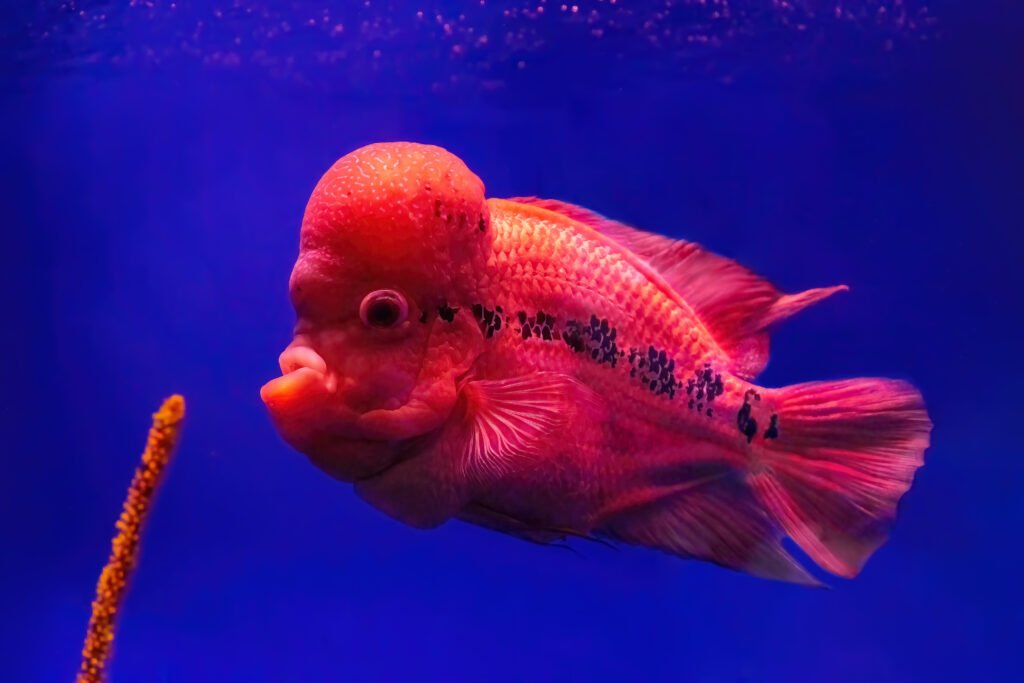
Varieties
One of the most fascinating aspects of flowerhorn fish is the sheer diversity of varieties available. Through selective breeding, a wide range of colors, patterns, and nuchal hump shapes have been developed, each with its own unique charm and appeal. Some of the most popular flowerhorn varieties include:
- Red Dragon (Kamfa): Known for their intense red coloration and impressive nuchal humps, red dragon flowerhorns are among the most sought-after varieties. Their scales often have a metallic, almost iridescent sheen, adding to their visual impact.
- Golden Monkey (Kamalau): These flowerhorns display a striking combination of gold, yellow, and orange hues, with black markings that resemble the face of a monkey. They are prized for their large, well-shaped nuchal humps and friendly personalities.
- Thai Silk: As the name suggests, Thai silk flowerhorns have a smooth, silky appearance, with colors that blend seamlessly from one shade to another. They often exhibit a mix of red, pink, and purple hues, creating a truly stunning display.
- Zhen Zhu (Pearl): Zhen Zhu flowerhorns are characterized by their pearlescent scales, which have a shimmering, almost metallic quality. They can come in a range of colors, from red and orange to blue and green, and are known for their compact, well-proportioned bodies.
- King Kamfa: Considered by many to be the “holy grail” of flowerhorns, king kamfas are renowned for their massive, perfectly shaped nuchal humps and intense, vivid coloration. These fish are the result of years of meticulous selective breeding and can command incredibly high prices in the aquarium trade.
The story of the king kamfa is a testament to the dedication and passion of flowerhorn breeders. It is said that a Malaysian breeder named Lam Seah Fatt spent over a decade carefully selecting and breeding the finest specimens from his red dragon and golden monkey lines, all in pursuit of creating the ultimate flowerhorn. The result was the king kamfa, a fish of unparalleled beauty and presence that has become the stuff of legend among flowerhorn enthusiasts.
Of course, these are just a few examples of the many flowerhorn varieties that exist. With new strains and color morphs constantly being developed, the possibilities are truly endless. Each variety has its own unique story and history, reflecting the creativity, skill, and vision of the breeders who brought them into existence.
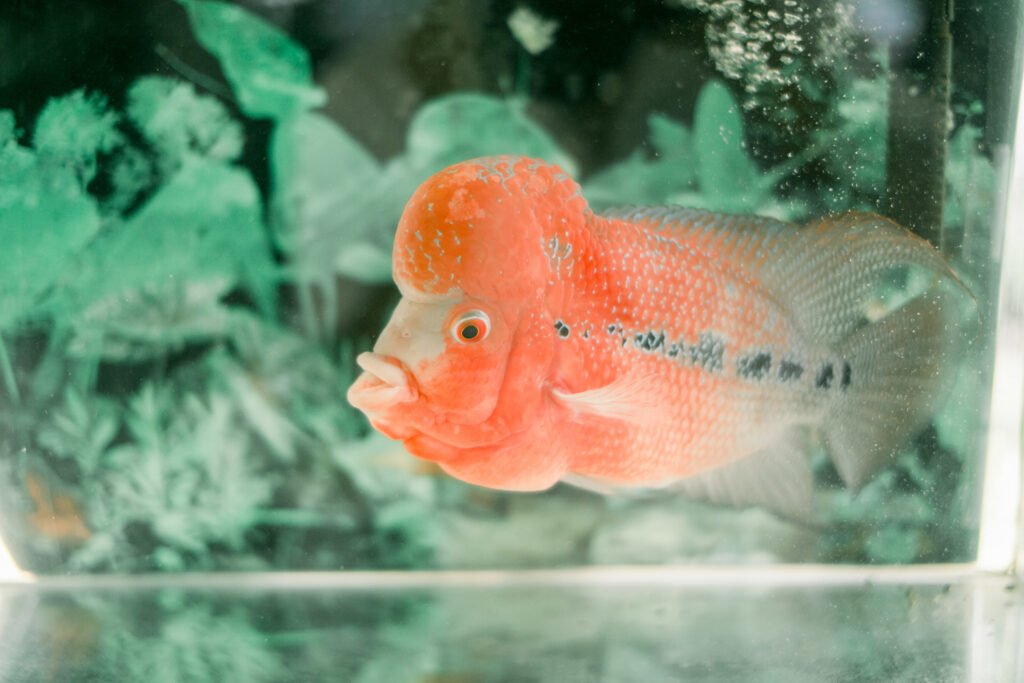
Care Guide
Caring for flowerhorn fish requires a combination of dedication, knowledge, and attention to detail. These unique cichlids have specific needs that must be met to ensure their health, vitality, and long-term well-being. Here are the key aspects of flowerhorn care:
Tank Size and Setup:
Given their potential size and semi-aggressive temperament, flowerhorns require a spacious aquarium to thrive. A minimum tank size of 75 gallons (284 liters) is recommended for a single adult flowerhorn, with larger tanks being ideal for providing ample swimming space and territorial boundaries.
When setting up a flowerhorn tank, create a natural and visually appealing environment with a mix of rocks, driftwood, and hardy plants. Flowerhorns appreciate open swimming areas, so be sure to leave plenty of space for them to move around freely. A sand or fine gravel substrate is suitable, and a powerful filtration system is essential to maintain excellent water quality.
Water Parameters:
As with most cichlids, maintaining stable and optimal water parameters is crucial for the health and well-being of flowerhorns. These fish are native to the warm, slightly alkaline waters of Central America and require the following conditions:
Temperature: 75-85°F (24-29°C)
pH: 7.0-8.0
Hardness: 9-20 dGH
Perform regular water changes of 10-20% per week to remove accumulated waste and maintain a healthy balance in the aquarium. Monitor water parameters closely using reliable test kits, and make adjustments as needed to keep the water within the ideal range for your flowerhorn.
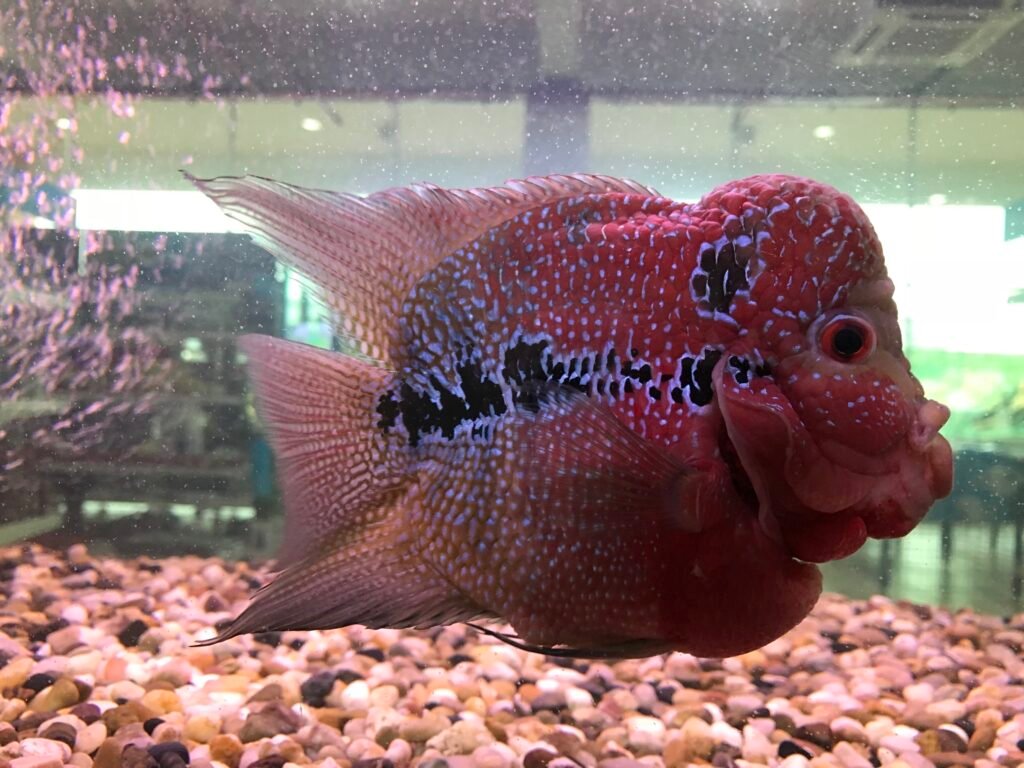
Diet and Feeding:
Flowerhorns are omnivorous and require a diverse, well-balanced diet to thrive. In the wild, they would feed on a variety of prey, including small fish, insects, crustaceans, and plant matter. In the aquarium, it is essential to provide a mix of high-quality pellets, frozen foods, and fresh vegetables to meet their nutritional needs.
A good quality cichlid pellet should form the base of your flowerhorn’s diet, supplemented with regular offerings of frozen foods such as bloodworms, brine shrimp, and mysis shrimp. Fresh vegetables like blanched spinach, lettuce, and peas can be offered a few times a week to provide essential fiber and nutrients.
When feeding your flowerhorn, aim for two to three smaller meals per day rather than one large feeding. This approach mimics their natural eating habits and helps prevent digestive issues. Be sure to remove any uneaten food after a few minutes to maintain good water quality.
Tank Mates:
Flowerhorns are best kept individually or with carefully selected tank mates due to their semi-aggressive nature and territorial tendencies. In a spacious, well-designed aquarium, they can coexist with other large, robust cichlids that can hold their own, such as oscars, green terrors, or jack dempseys.
When choosing tank mates for your flowerhorn, consider species that have similar water requirements, temperaments, and feeding habits. Always research potential companions thoroughly and be prepared to separate or rehome fish if compatibility issues arise.
Common Health Issues:
Like all fish, flowerhorns are susceptible to various health problems if their needs are not met. Some common issues to watch out for include:
- Hole-in-the-Head Disease: Caused by poor water quality, nutritional deficiencies, or parasitic infections, this condition manifests as pitted lesions on the head and body of the fish.
- Ich: A parasitic infection characterized by small white spots on the skin and fins, ich is often triggered by stress or poor water conditions.
- Fin Rot: This bacterial infection causes the fins to become frayed, discolored, or even fall off, and is usually a result of poor water quality or injury.
Regular monitoring, maintaining excellent water quality, and providing a balanced diet are the best ways to prevent and manage these health issues. If you suspect your flowerhorn is unwell, consult with a knowledgeable aquarist or veterinarian specializing in fish care for guidance and treatment options.
Breeding
Breeding flowerhorn fish is a complex and often controversial topic, as it involves the selective crossing of different cichlid species to create new strains and varieties. While many hobbyists are content to simply enjoy these unique fish in their aquariums, others are driven by the challenge and rewards of producing the next generation of flowerhorns.
The story of flowerhorn breeding is one of passion, dedication, and endless experimentation. Breeders around the world, particularly in Southeast Asia, have spent decades refining their techniques and developing new color morphs and nuchal hump shapes. The process often involves carefully selecting parent fish with desirable traits and then crossing them to produce offspring that exhibit the best characteristics of both.
One of the most famous stories in flowerhorn breeding lore involves a Taiwanese breeder named Lam Seah Fatt, who is credited with creating the highly sought-after king kamfa strain. According to legend, Lam spent over a decade meticulously selecting and breeding the finest specimens from his red dragon and golden monkey lines, all in pursuit of the ultimate flowerhorn. The result was a fish of unparalleled beauty and presence, with a massive, perfectly shaped nuchal hump and intense, vivid coloration.
Of course, not all breeding efforts are as successful or well-documented as the creation of the king kamfa. Many breeders work tirelessly behind the scenes, experimenting with different crosses and line-breeding techniques to produce new and exciting varieties. The process can be time-consuming, expensive, and often unpredictable, with no guarantee of success.
For hobbyists interested in breeding flowerhorns, it is essential to have a solid understanding of genetics, fish husbandry, and the specific requirements of the species involved. A dedicated breeding tank with optimal water conditions, a well-balanced diet, and a suitable pair of parent fish are all necessary components of a successful breeding program.
When a male and female flowerhorn are ready to spawn, they will engage in a fascinating courtship dance, with the male displaying his vibrant colors and impressive nuchal hump to attract the female. If the female is receptive, she will lay her eggs on a flat surface, which the male will then fertilize. The parents will typically guard their eggs and fry for a short period before the breeder removes them to a separate grow-out tank.
As the fry develop, they will require a diet of small, nutrient-rich foods such as newly hatched brine shrimp and finely crushed flakes. Regular water changes and careful monitoring of water quality are essential to ensure the health and survival of the young flowerhorns. As they grow, the breeder will need to make decisions about which individuals to keep, sell, or use in future breeding efforts based on their appearance, size, and overall quality.
While the world of flowerhorn breeding can be fascinating and rewarding, it is important to approach it with caution and respect for the fish involved. The creation of hybrid species is a controversial topic in the aquarium hobby, with some purists arguing that it undermines the integrity of natural cichlid populations and contributes to genetic pollution. As with any breeding effort, the welfare and long-term well-being of the fish should always be the top priority.
Conclusion
The story of flowerhorn fish is one of passion, creativity, and the endless possibilities of the aquarium hobby. From their humble beginnings as an experimental hybrid to their current status as one of the most sought-after and beloved cichlids in the world, these remarkable fish have captured the hearts and imaginations of enthusiasts everywhere.
Whether you are drawn to their vibrant colors, impressive nuchal humps, or engaging personalities, there is no denying the allure of flowerhorns. Keeping these unique fish can be a challenging but immensely rewarding experience, offering the opportunity to observe and interact with a true work of living art.
However, as with any living creature, the decision to keep flowerhorns should not be taken lightly. These fish require a significant investment of time, resources, and dedication to thrive, and their breeding and propagation remain controversial topics in the aquarium community. As responsible hobbyists, it is our duty to prioritize the health, well-being, and long-term sustainability of the fish we keep, regardless of their origin or appearance.
In the end, the story of flowerhorns is still being written, with new varieties, breeding techniques, and debates emerging all the time. Whether you are a seasoned enthusiast or a curious beginner, there has never been a more exciting time to explore the fascinating world of these unique and captivating fish. With the right knowledge, care, and appreciation, flowerhorns can bring joy, beauty, and endless inspiration to our aquariums and our lives.
Views: 3

